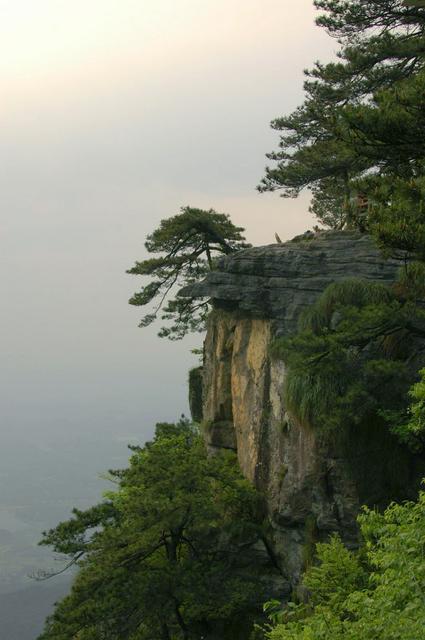 Lushan is a city in Jiangxi.
Lushan is a city in Jiangxi.
Lushan (庐山) is a mountain area with the touristy township Guling at an altitude of about 1000 metres and the surrounding mountains up to Dahanyang peak at about 1500 metres, in Jiangxi province. After a long Buddhist history, it was built up by British colonialists as a summer hill station, and still bears evidence of their architecture (both real and obviously contrived). It still makes for a refreshing escape from the summer heat, and offers many scenic hiking opportunities and some historic buildings, particularly of interest for fans of Communist Party history. It is very popular with the better heeled Chinese tourist, but well off the beaten path for independent foreign travellers and accordingly you should expect some communication difficulties. It is hoped it was enjoyed by Chairman Mao, as his visage in cane chair features in front of the many picturesque spots, with more than a little assistance from Photoshop. This mountain area is listed as a UNESCO World Heritage Site and UNESCO Global Geopark.
Pick up a map at the bookstore on Guling Jie for a guide to various old "villa"-style buildings in town, and various natural sites around town of waterfalls, peaks, etc. A very pleasant walk is to follow Dalin Jie down past Ruting Lake for a stroll around the botanical gardens. From there follow the cliff along a man-made path that picks up many spectacular views and passes many items of natural interest. In due course this path arrives at the Sante rollerway, a contraption of dual rails and a 2-person car that descends through the forest. It's a worthwhile ride, as it is time for a rest and the opportunity to be grateful that the primitive braking system works. The cliffside walk continues until far below it reaches a suspension bridge and a chairlift back up to the mountain. There might also be a taxi at the bottom, or you can walk up the narrow concrete road to the main road at the top and hail a bus back to Guling. Allow about 4 hours for this whole excursion.
- Sandiequan. Spectacular three-step waterfall, totalling 155m of falls, inside a deep canyon. Often described as the unmissable highlight of the park. The main trail climbs steeply up the end of the valley, with a ridge separating it from the falls, to connect with a miniature funicular railway or trail to the rest of the park. A small tourist complex sits by the pool at the bottom of the falls, and a trail accesses the base of the middle section of the falls (Erdiequan), via another long, steep stairway. There is no access to the base of the upper section of the falls.
- Jin Xiugu. Stone steps from the bridge through the left side of road before the trip to the Fairy Cave, about 1.5 km to a beautiful valley. Eastern Jin Dynasty monk Hui Yuan is said to pick flowers, herbs Department.
Sandiequan. Spectacular three-step waterfall, totalling 155m of falls, inside a deep canyon. Often described as the unmissable highlight of the park. The main trail climbs steeply up the end of the valley, with a ridge separating it from the falls, to connect with a miniature funicular railway or trail to the rest of the park. A small tourist complex sits by the pool at the bottom of the falls, and a trail accesses the base of the middle section of the falls (Erdiequan), via another long, steep stairway. There is no access to the base of the upper section of the falls.
Jin Xiugu. Stone steps from the bridge through the left side of road before the trip to the Fairy Cave, about 1.5 km to a beautiful valley. Eastern Jin Dynasty monk Hui Yuan is said to pick flowers, herbs Department.
There are many dining opportunities in Guling, from the main restaurants overlooking the view, to the smaller restaurants in the side streets. Menu design, prices, and much of the selection are standardized, but there can be significant variation in the number of options and restaurants will often offer discounted specials. Some restaurants have a wall of pictures, otherwise non Chinese speakers will have to improvise. Major tourist stops often have snacks available, and occasionally a restaurant, but these may close during non-peak times.
Going North connect through Jiujiang (九江) and going south connect through Nanchang (南昌). Buses to both can be found leaving from the bus stations on Hexi Lu(河西路), to get there head east on Guling Jie until you see a tunnel on your right. Go through the tunnel and buses to Jiujiang will be right in front of you and buses to Nanchang will be on your right.
The high-speed rail options at Jiujiang make it relatively easy to visit Wuyuan, Huangshan, and Jingdezhen.
